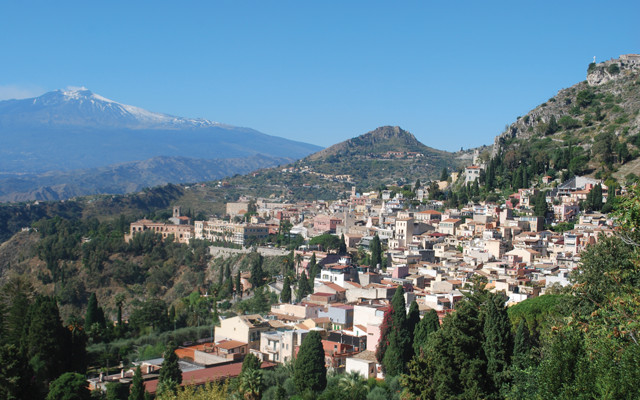
by Elizabeth Goldbaum Monday, August 15, 2016

Mount Etna, seen here beyond the Sicilian town of Taormina, rises to a height of more than 3,300 meters. Credit: Miguelftorres, CC BY-SA 3.0.
Europe’s tallest active volcano, Mount Etna, rises 3,300 meters above the island of Sicily, which lies just off the coast of Italy’s “toe.” Within 100 kilometers of more than 3 million people, Etna frequently rumbles and occasionally belches. As recently as last May, explosions accompanied lava fountains and ash erupted from one of the volcano’s craters over several days. This was just one of many eruptions in a long line of events, with historical documents dating similar outbursts back to 1500 B.C. Scientists cannot pinpoint when Etna will next erupt, but in a new study in Geology, researchers have identified a clue that may help them better understand how the volcano’s inner plumbing system changes just prior to an eruption.
From 2001 to 2013, Antonio Paonita, a geochemist at Italy’s National Institute of Geophysics and Volcanology and lead author of the study, and his colleagues visited Mount Etna every two weeks to collect samples of gases seeping out of four vents lying between 15 and 20 kilometers from the summit. These fumes — which contain mostly water vapor and carbon dioxide, but also other volatiles — rise to the surface after degassing from magma beneath the volcano; and as the magma composition changes, so does the mix of gases released.
Etna erupted six times during this 12-year inspection, spewing more than 10 million cubic meters of magma each time. Analyzing the dataset, the team found that eruptive activity was preceded, in five out of the six cases, by increases in the ratio of helium-3 to helium-4 measured in the vent gases, a change lasting from a few weeks to several months. (An eruptive event in 2004–2005 was the exception.) As mantle material is enriched in helium-3 and has higher helium-3 to helium-4 ratios relative to the crust, increases in the helium ratios measured in vented gases reveal how much magma is entering the volcano’s deep magma chamber and how much pressure builds as a result, Paonita says.
“This is a really novel study,” says Jacob Lowenstern, a research geologist with the U.S. Geological Survey’s Yellowstone Volcano Observatory who was not involved with the research. “There are very few places and very few volcanoes where there’s such an intensive time series” of data, he says. The strong correlation of helium isotope ratios among the four different vents, seen throughout the time series, implies that a deep magma reservoir “at least 10 kilometers or so down, is the source of the bulk of the helium that’s coming out at the surface,” Lowenstern says.
The link between helium isotope variations and increased pressurization in volcanic systems caused by deep magma flows is supported by observed changes in ground deformation, which are typically measured using satellite imagery and GPS receivers that reveal how the ground swells and deflates over time, Lowenstern says.
The study’s results also corroborate what fellow Etna researchers have found, says Sonia Calvari, a volcanologist at the National Institute of Geophysics and Volcanology who was not part of the study. Calvari has studied the volcano using thermal cameras to show how it changes during eruptions. The new study’s helium data, combined with ground- and space-based thermal and seismic measurements of Mount Etna, could help researchers predict future eruptions of the volcano more confidently, Calvari says.
The study could potentially be applied to other volcanoes if they also show similar correlations with helium isotopes, Paonita says. However, Lowenstern notes, every volcano is different, and Etna is special because it erupts so often and is so heavily studied. Applying similar methods to other volcanoes can help researchers learn more about those volcanoes, he says, but you can’t “necessarily jump to the conclusion that helium isotopes are always a sign of an impending eruption.”
© 2008-2021. All rights reserved. Any copying, redistribution or retransmission of any of the contents of this service without the expressed written permission of the American Geosciences Institute is expressly prohibited. Click here for all copyright requests.